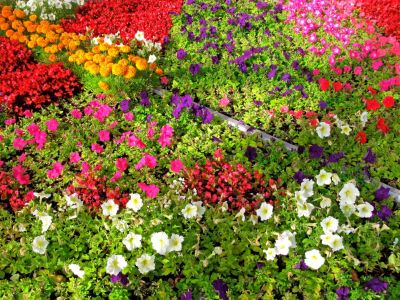The only character trait that unites the large family of annual flowers is that they all die off at the end of the season, making it ever so enjoyable to start again with a whole new palette of color, texture, and perfume the next season.
Planting Annual Flowers
Even a die-hard perennial fan like me can appreciate the simplicity of the annual flower. You either start the annual from seed in the spring, following package directions; or buy the plant from your local nursery. Simply plant the flowers or seeds in the right location – sun, partial sun, or shade – provide them with a moderately rich, moist soil, and you’ll have hoards of color in no time at all. Annual plants are perfect for planting in containers on your porch or patio, or for filling in the gaps in your perennial beds or vegetable garden. They will never overtake the bed they’re planted in because they inevitably retire to plant heaven at the end of the season. Choosing annual flowers is easy. Some of our most beloved flowers belong to the annual family. Remember your grandmother’s flower bed with the purple petunias and pink pansies? Or perhaps it was your grandfather’s vegetable garden with marigolds forming a bright yellow and orange outline. In addition to these all-time classics, there are some lesser-known annuals that should be given a second look. In moist locations like the Pacific Northwest, the blue forget-me-not and the brilliant coleus, known for its red, green, white, and yellow foliage, are great selections. In a drier climate, the moss rose (Portulaca) as well as the everlasting statice are true low-maintenance delights in the garden. Be sure to harvest the papery statice blossoms for a winter bouquet when the air is turning cold.
Tips for Growing Annual Gardens
Here are a few simple tips and tricks to keep in mind when you begin your adventure in annual garden design:
When purchasing from a nursery, make sure annual plants are well-rooted. Give the annual a gentle tug; it shouldn’t feel loose. Be careful not to purchase large, overgrown, or wilted plants. The soil should be moist and the plant should be perky and no larger than three times the size of the container. If purchasing seeds, buy from a few different companies first to see which seeds produce the best results for you. When planning the annual garden design, sketch the layout on paper first using design ideas you’ve enjoyed in magazines or catalogs. Then use cutouts of plants from nursery or seed catalogs to fill in the “paper bed” and make sure the colors blend. Be sure to select the right plants for the desired garden spot. If your annual bed is near trees or a house, be sure it receives adequate sunlight for the annual plants you want. Prepare your soil bed with lots of compost and decaying leaves or grass clippings. Don’t be afraid to fertilize your annuals once they’re in the bed with a good, preferably organic, fertilizer that promotes blooming and strong plants. Organic fertilizers protect our children, pets, and wildlife from serious harm. Always keep all fertilizers out of the reach of loved ones.
Before you know it and with these tips for growing annual gardens, mounds of color and sweet perfume will soon overtake your landscape.
